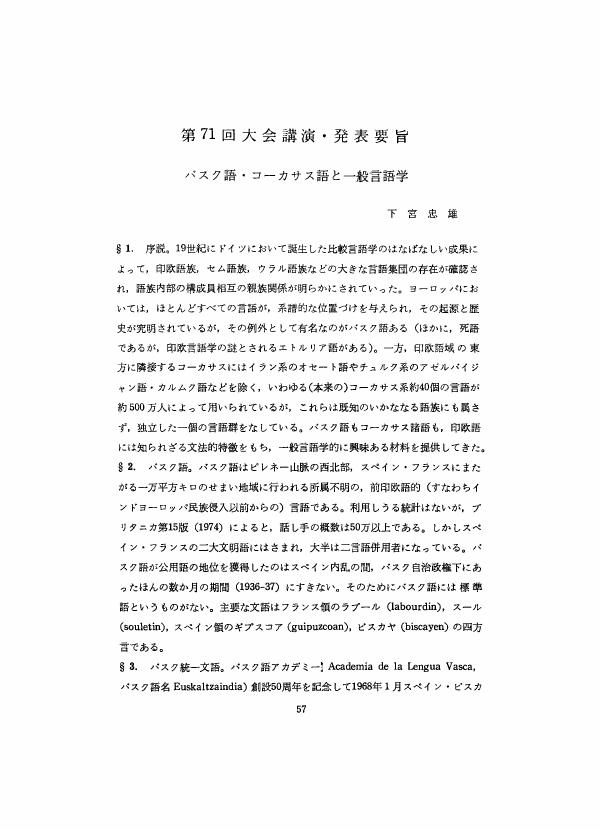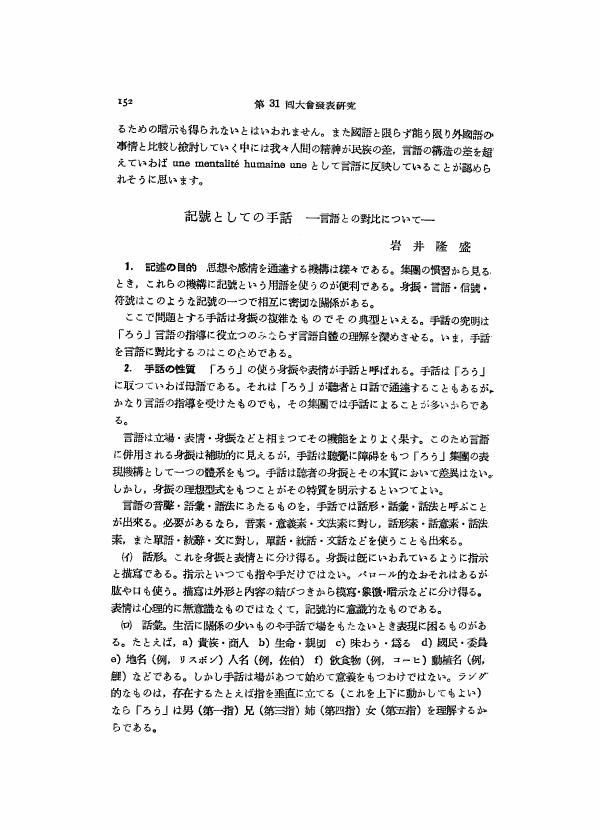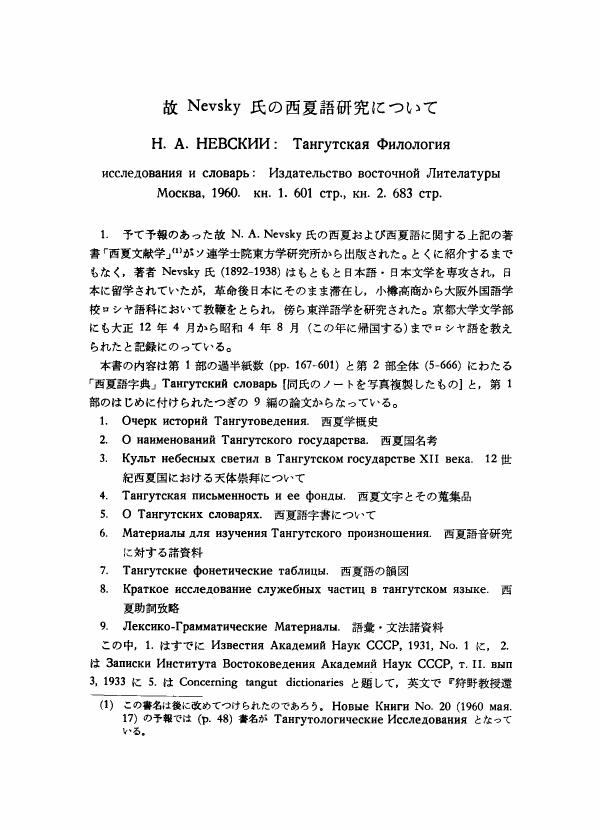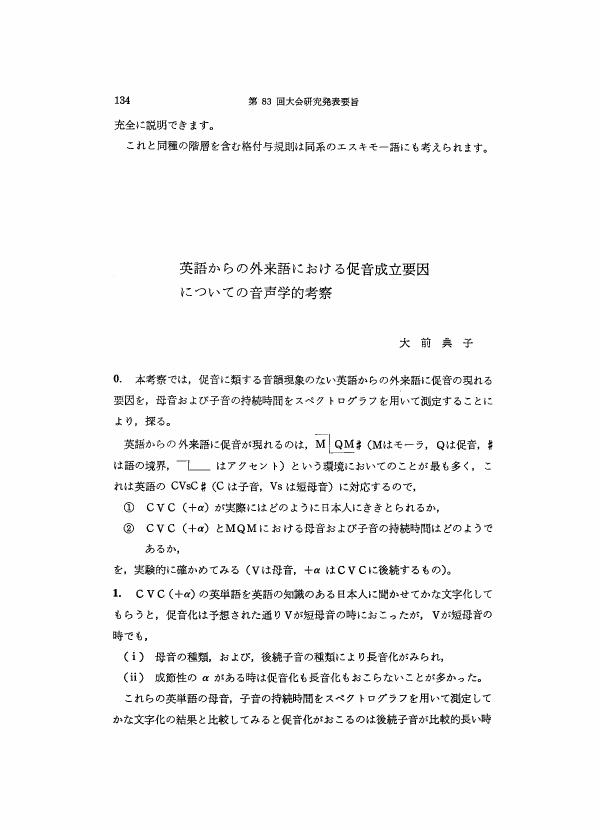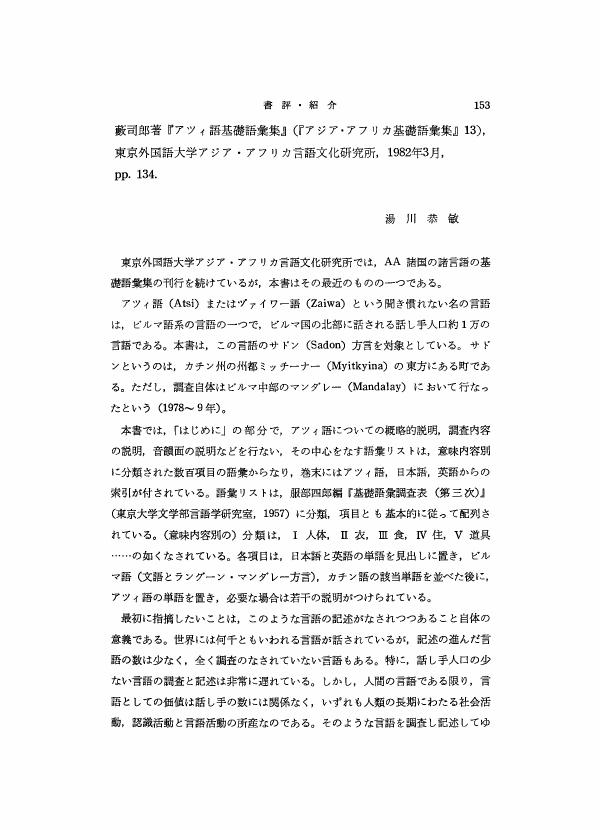1 0 0 0 OA 第71回大会講演・発表要旨
1 0 0 0 OA 上古漢語の音韻体系
- 著者
- 小倉 肇
- 出版者
- The Linguistic Society of Japan
- 雑誌
- 言語研究 (ISSN:00243914)
- 巻号頁・発行日
- vol.1981, no.79, pp.33-69, 1981-03-31 (Released:2011-02-18)
- 参考文献数
- 62
From the phonemic point of view, the author attempts to review the reconstructions of Archaic Chinese sound system by B. Karlgren, Tung T'ungho (董同和). He modifies their reconstructions and presents his phonemic interpretation of the initials and the finals in Archaic Chinese. To summarize the conculusion of his interpretation, the phonemic system of Archaic Chinese is as follows.1) Initial consonants:p-p′-b-m-t-t′-d-n-l-ç-j-ts-ts′-dz-s-z-k-k′-g-η-x-γ-2) Medials:-φ-(zero)-r-u-3) Vowels:(i)(u)e e Aa a4) Final consonants:-m-p-b-n-t-d -r-D-k-g-uη-uk-ug
1 0 0 0 OA 記號としての手話
- 著者
- 岩井 隆盛 横山 辰次
- 出版者
- The Linguistic Society of Japan
- 雑誌
- 言語研究 (ISSN:00243914)
- 巻号頁・発行日
- vol.1954, no.26-27, pp.152-154,187, 1954-12-25 (Released:2010-11-26)
1 0 0 0 OA ある方言地図の解釈
- 著者
- 加藤 正信
- 出版者
- The Linguistic Society of Japan
- 雑誌
- 言語研究 (ISSN:00243914)
- 巻号頁・発行日
- vol.1962, no.42, pp.31-46, 1962-10-31 (Released:2010-11-26)
As an experiment in linguistc geography, the writer takes up in the present paper the distribution of a variety of forms denoting salix caprea in the Island of Sado. This word may not belong to the basic Japanes vocabulary, nor can its variation constitute such an important dialectological feature as the word for “bought”, which divides Japan into two areas, one (east) with the form katta and the other (west) with the form kota. Even the conclusion about the changes the word has undergone in that island may have little significance in itself. The writer's aim here is to present the procedures that have led him to his conclusion and invite critical comments from his colleagues.In actual field work, the writer was assisted by Mrs. Sadako Kato. They visited almost all the communities (160 communities in all) in the island except the northern region, from 1959 to 1962. In each community, they examined one informent, who was native to the community and born in the Meiji Era i. e. before 1912. As a result of the survey, 34 different forms have been recorded. If we represent these forms on the maps as they are, their distribution would look so complicated that it would be impossible to know where to draw a dividing line. Matters can be made much simpler, however, by classifying our forms into two groups, one containing the element inu ‘dog’ and one containing the element neko ‘cat’. Thus we find the ‘dog’ group distributed in the central part, and the ‘cat’ group along the seacoast.With respect to the history of the island, we know that it was the central part that was prosperous untill the sixteenth century, and, only later, important lines of communications developed along the coast. On the other hand, the ‘dog’ group contains certain forms affected by a law of vocalic change that must have been completed in the seventeenth or eighteenth century. These two considerations have led the writer to the conclusion that the ‘dog’ group belong to an older layer than the ‘cat’ group. If so, how did some forms of the ‘dog’ group come to be replaced by those of the ‘cat’ group? In order to answer this question, the writer reconstructs an approximate process of innovation on the basis of further material provided by his map, and considers factors involved in each case.
1 0 0 0 OA 日本語受動の類型論
- 著者
- 宮腰 幸一
- 出版者
- 日本言語学会
- 雑誌
- 言語研究 (ISSN:00243914)
- 巻号頁・発行日
- vol.157, pp.113-147, 2020 (Released:2020-12-10)
- 参考文献数
- 34
本稿は日本語受動の新たな類型論を提案・実証する。主な提案は次の7つである。[I]日本語受動は[1]受影主受動と[2]経験主受動に大別され,それぞれさらに下位分類される。[II]ラレルは2(+1)項助動詞であり,意味と統語の両レベルで[1]よりも[2]の方が階層的に上位の構造を持ち,[2]の中でもあるタイプ([A]直接・[B]所有1)よりも別のタイプ([C]所有2・[D]間接)の方がより複雑な構造を持っている。[III]すべてのタイプにおいて意味レベルの束縛が重要な役割を果たす。[IV]受動の本質的特性である〈受影性〉は6つの認可条件と3つの階層で複合的に規定される。[V]日本語受動の典型は[2A]タイプであり,それは主体的把握・内界表出文である。[VI]それがプロトタイプであることは三重受影性階層から定理として導き出される。[VII]非典型的なタイプも,受影主や複合事象/複雑述語文の一般的な派生度測定基準/方法の導入により,原理的に説明される。
1 0 0 0 OA 文脈指示における指示詞の使い分けについて
- 著者
- 堤 良一
- 出版者
- The Linguistic Society of Japan
- 雑誌
- 言語研究 (ISSN:00243914)
- 巻号頁・発行日
- vol.2002, no.122, pp.45-78, 2002-09-25 (Released:2007-10-23)
- 参考文献数
- 34
The purpose of this paper is to build a model that gives a natural explanation of the distribution of demonstratives in the anaphoric use. Discourse Management Theory (DMT; Takubo and Kinsui (2000) among others) provides a persuasive model for this issue. However, this theory faces some difficulties, especially when dealing with sentences such as those presented in Iori (1997) and Tsutsumi (1998). I argue that this is because the theory is strongly based on the concept of ‘experience, ’ however, these problems are solved when we adopt the model presented in this paper.We create (at least) two worlds in our mind: one of these is Ws and the other is Wp. Ws is the world in which we refer to things directly (such as proper nouns and things that the speaker believes to exist in the real world (Wo)) while Wp is the world where every element is altered to a variable (x, y). Following Tsutsumi (1998), we assume that Ko/A-series refer to elements in Ws and So-series to those in Wp.This predicts that if an object is registered in both of the worlds, then both Ko (A) /So-series can be used. If it is registered in only Ws or Wp, then only Ko (A) or So can be used respectively. This idea is reminiscent of that of DMT's, however, by abandoning the concept of ‘experience, ’ and introducing the idea of ‘variable’ for the So-series demonstratives, we succeed in explaining a wider range of data than DMT can deal with.
1 0 0 0 OA 故Nevsky氏の西夏語研究について
- 著者
- 西田 龍雄
- 出版者
- 日本言語学会
- 雑誌
- 言語研究 (ISSN:00243914)
- 巻号頁・発行日
- vol.1962, no.41, pp.55-65, 1962-03-30 (Released:2010-11-26)
- 参考文献数
- 10
1 0 0 0 OA 長崎通事のポルトガル語について
- 著者
- 土井 忠生
- 出版者
- The Linguistic Society of Japan
- 雑誌
- 言語研究 (ISSN:00243914)
- 巻号頁・発行日
- vol.1969, no.54, pp.73-83, 1969-01-20 (Released:2010-11-26)
“Nanshizakkai”is a manuscript of three volumes, which was transcribed by a Tongking jurubaca (means an interpreter in Malay word), Gi Gozaemon (d. 1835). This book has a charactor which is called one of the Japanese-Portuguese dictionary, and in which we find the Portuguese language used by interpreters in Nagasaki during 17 th and 18 th centuries, and also we recognize some linguistic features of Portuguese spoken among the Japanese interpreters. Of course the phase of it was different from that of some lingusitic works compiled by Jesuit missionaries in 16 th and 17 th centuries. In this book Portuguese is written by Katakana. We are able to ascertain the practical pronunciations of that time by means of that orthography. First of all, double consonants in one syllable of Portuguese were reduced to open syllables according to the Japanese syllabic type, e. g. letra>reutara, escrito>esukirito; second, two words fused into one, e. g. ja estou>jastou, de ontem>dontem, and also abbreviations were often used, e. g. alguma>goma, ainda>ain.The word order was freely treated, e. g. Portuguese word order was arranged by Japanese order. The compiler of this book explained that the following three expressions had the same meaning: arroz um fardo, um fardo arroz.fardo um arrozPortuguese has the complicated system of conjugations, of which interpreters, generally speaking, adopted present an preterite of Indicative. They used infinitive and present for other conjugated forms. Subjects did not always coordinate with Predicates in Person and Number. The form of Third Person, Singular of Conditional expressed more honorary than usual Imperative form. e. g.Anda por deante. Arnie Vossa Merce por deante.Faze corn deligencia. Faza Vossa Merce corn deligencia.Descobri.Descobra Vossa Merce.This proper use in Portuguese syntax was exactly kept by the Japanese interpreters, because it has the correspondency to the sence of Japanese honorifics.It had the special function to compound with aru after Portuguese words or sentences. Aru was added at the end of predicate or sentence, to make sure of the meaning of preceeding words. e. g. Ir templo aru. Veio arudo. Assi como imitar aprende aru. Saber de coy dearudo. Näo tern novas deyado. Meu (genitive was used for nominative) de dia denoite tern sono aru. It seems to me that it had some relations to the Portuguese verb ending, ar, at the same time, to the Japanese verb, aru.I will, therefore find out the facts of Japanese influence upon Portuguese, at any rate I would like to point out the Japanese sentence particle, ya was added to interogative sentences, and other sentence particles, yo, do were added to imperative forme. e. g. Vossa Merce ter fome ya? Que parte veio ya? Vive yo! Escreva memoria do!
1 0 0 0 OA 中期朝鮮語の母音調和と母音交替
- 著者
- 泉井 久之助 羅 鐘浩
- 出版者
- The Linguistic Society of Japan
- 雑誌
- 言語研究 (ISSN:00243914)
- 巻号頁・発行日
- vol.1968, no.52, pp.1-32, 1968-01-31 (Released:2010-11-26)
- 参考文献数
- 71
The prevailing vowel system of Middle Korean consisted of a group of wide vowels (a, ∧, o), a group of narrow vowels (∂, i, u), and a neutral vowel (i). The formation of words was then performed strictly according to the vowel harmony based on these groupings. However, there were several, or rather many word pairs of which the formation was realized either with wide vowels or narrow ones without seemingly diverging in their meanings or meaning shades.In early modern Korean where the system began to decay and the harmony ceased to operate, the word pairs with alternation of vowels wide and nerrow have feen fixed in their respective forms diverging more clearly in their meaning or acceptation one member from the other of the pair. Many pairs of this kind can be found still in cantemporary Korean language.The vowel system of Korean is generally far different from those of many Uralic and Altaic languages, even from that which is presupposed by Izui to have been in archaic Japanese.Works of many scholars of contemporary Korea are cited and consulted here.
1 0 0 0 OA 日本語アクセントの再建
- 著者
- 上野 善道
- 出版者
- 日本言語学会
- 雑誌
- 言語研究 (ISSN:00243914)
- 巻号頁・発行日
- vol.130, pp.1-42, 2006 (Released:2021-09-15)
- 参考文献数
- 31
現代方言と古文献資料に基づき,本土諸方言のアクセント祖体系を考える.高起群には従来の「高高高高…」の式音調を改訂して「高高中中…」の下降式を建てる.低起群には去声始まりのアクセント型などを組み込む.全体として,下降式と低進式の2つの式,それに昇り核と下げ核の2つの核からなる,従来よりも対立数を増やした私案を述べる.
1 0 0 0 OA 英語からの外来語における促音成立要因についての音声学的考察
- 著者
- 大前 典子
- 出版者
- 日本言語学会
- 雑誌
- 言語研究 (ISSN:00243914)
- 巻号頁・発行日
- vol.1982, no.81, pp.134-136, 1982-03-31 (Released:2010-11-26)
- 参考文献数
- 4
1 0 0 0 OA 動態測定による日本語アクセントの解明
- 著者
- 杉藤 美代子
- 出版者
- The Linguistic Society of Japan
- 雑誌
- 言語研究 (ISSN:00243914)
- 巻号頁・発行日
- vol.1969, no.55, pp.14-39, 1969-03-31 (Released:2010-11-26)
- 参考文献数
- 4
1 0 0 0 OA イ落ち:形と意味のインターフェイスの観点から
- 著者
- 今野 弘章
- 出版者
- 日本言語学会
- 雑誌
- 言語研究 (ISSN:00243914)
- 巻号頁・発行日
- vol.141, pp.5-31, 2012 (Released:2022-03-08)
- 参考文献数
- 53
本稿は,「ださっ。」や「気持ち悪っ。」のような,形容詞の終止形活用語尾「い」が脱落し,形容詞語幹が声門の閉鎖を伴って発話された口語表現(「イ落ち構文」)を記述し,当該表現における形と意味の相関関係を明らかにすることを目的とする。統語的には,イ落ち構文は,C,T,Negの機能範疇を欠き,小節(small clause)が主節を形成する“root small clause”(Progovac 2006)の一種とみなすことができる。意味的には,イ落ち構文は,発話時における話者の感覚や判断を,「伝達」ではなく,「表出」する「私的表現行為」(Hirose 1995,廣瀬1997)専用の構文である。本稿では,このイ落ち構文の統語的特徴と意味的特徴を照らし合わせ,当該構文において,動機付け・類像性・有標性の相互に関連する観点から,形と意味が恣意的ではなく有機的に結びついていることを論じる。
1 0 0 0 OA 書評・紹介 藪司郎 著 『アツィ語基礎語彙集』
- 著者
- 湯川 恭敏
- 出版者
- 日本言語学会
- 雑誌
- 言語研究 (ISSN:00243914)
- 巻号頁・発行日
- vol.1983, no.84, pp.153-155, 1983-11-15 (Released:2013-05-23)
1 0 0 0 OA 方言の地域差から年齢差へ ――庄内浜荻追跡調査の多重対応分析――
- 著者
- 井上 史雄 半沢 康
- 出版者
- 日本言語学会
- 雑誌
- 言語研究 (ISSN:00243914)
- 巻号頁・発行日
- vol.162, pp.63-89, 2022 (Released:2022-10-25)
- 参考文献数
- 62
本稿では山形県庄内地方で行われた方言調査データに多重対応分析を適用した結果を報告する。江戸時代の方言集『浜荻』掲載406語の残存率について1950年に3世代,2018年に4世代の調査が行われ,長期の言語変化が分かった。「年齢柱方言地図」と「単純化グロットグラム」を作図して考察した。140年にわたる世代差を踏まえ,20世紀の地域差の大きい時期から,21世紀の世代差の大きい時期に移行したことを論じる。多重対応分析によって方言の分布と変化の複雑なパターンを要約し,全体傾向を把握できた。第1軸には140年という長さの年齢差が表れ,第2軸以下には庄内方言南北80 kmの地域差が示された。南北差が大きいので,鶴岡からの徒歩距離を計測して「単純化グロットグラム」を作成し,代表的な8語のうち3語を例示した。地方的周圏分布が見られるとともに,現在の若い世代の急速な方言衰退が見られ,他方中学生による方言使用も観察された。
1 0 0 0 OA ロシア語の〈1回体動詞〉
- 著者
- 佐藤 純一
- 出版者
- 日本言語学会
- 雑誌
- 言語研究 (ISSN:00243914)
- 巻号頁・発行日
- vol.1968, no.52, pp.107-109, 1968-01-31 (Released:2011-10-21)
- 参考文献数
- 5
1 0 0 0 OA 東京方言の音韻化規則
- 著者
- 早田 輝洋
- 出版者
- The Linguistic Society of Japan
- 雑誌
- 言語研究 (ISSN:00243914)
- 巻号頁・発行日
- vol.1966, no.49, pp.55-69, 1966-03-31 (Released:2013-05-23)
- 参考文献数
- 6
This paper attempts to describe the phonological component of a generative grammar of Japanese. The phonological component is an input-output device, the input into which is a sequence of morphemes generated by the syntactic component and the output a sequence of phones with the pitch contour.Three different kinds of accent marks are employed in order to prescribe the accent pattern of a concatenated word group.Rules (R 1)-(R 13) rewrite grammatical formatives as a sequence of phonological symbols.Rules (R 14)-(R 35) convert phonological symbols and boundary elements into phonemes.Rules (R 36)-(R 44) determine the word accent.Rules (R 45)-(R 46) deal with the devocalization of vowels.Rules (R 47)-(R 54) give the pitch contour.Some rules in the syntactic component are also discussed.
1 0 0 0 OA 書評、紹介、消息 時枝誠記 著 『日本文法 口語篇』
- 著者
- 山田 俊雄
- 出版者
- 日本言語学会
- 雑誌
- 言語研究 (ISSN:00243914)
- 巻号頁・発行日
- vol.1951, no.19-20, pp.157-164, 1951-12-25 (Released:2013-05-23)
1 0 0 0 OA 一人称代名詞の包括形・除外形の体系
- 著者
- 早田 輝洋
- 出版者
- The Linguistic Society of Japan
- 雑誌
- 言語研究 (ISSN:00243914)
- 巻号頁・発行日
- vol.2004, no.125, pp.145-171, 2004-03-25 (Released:2007-10-23)
- 参考文献数
- 12
Chinese and Manchu have been said to have a distinction between the ‘inclusive we’ including the hearer(s) and the ‘exclusive we’ excluding the hearer(s). However, in both Chinese and Manchu, sometimes the inclusive we is used for a group which does not include the hearer(s) and sometimes the exclusive we is used for a group which does include the hearer(s). An attempt is made here to account for all the exceptions and show, based on the uses of the first person plural pronouns in fin Ping Mei, and its Manchu translation prefaced in 1708, that for both Chinese and Manchu the inclusion of the hearer(s) is irrelevant in the distiction between the so-called inclusive and exclusive, and that the distinction between the two is between the absence and the presence of the feature [part]. An inclusive pronoun, thus, is simply a first person plural pronoun unspecified for [part], whereas an exclusive one, which is specified as [part], denotes the part of a whole including the speaker and other(s), and presupposes the remaining part of the whole. The proposed system is shown as follows:exclusively singular- exclusivelysingular plural pluralINCLUSIVE zan za(n)men, za(n)mei'unmarked (Manchu: muse)(whole-part)'wo(Manchu: bi, min-)EXCLUSIVE an, anmen women‘marked(part)’ (Manchu: be, men-)Manchu does not employ the singular-plural pronouns. The present-day Chinese of Peking follows only the exclusively singular and exclusively plural Manchu-type system. Although an and anmen occur far more than women in Jing Ping Mei, in present-day Peking an and anmen have fallen out of use and women prevails. It is not unreasonable to think that the extinction of an and anmen originated from the Manchu-type system used by Manchus in Peking who had ceased to use Manchu and begun to speak Chinese.
- 著者
- Shigeki Kaji
- 出版者
- The Linguistic Society of Japan
- 雑誌
- 言語研究 (ISSN:00243914)
- 巻号頁・発行日
- vol.Supplement.1, pp.41-68, 2021 (Released:2021-11-09)
- 参考文献数
- 12
Africa south of the Sahara has been characterized by its orality, i.e., as societies without writing systems. In actual fact, however, field research reveals a number of phenomena which function to record messages and events, although they may not appear to at first sight. In this article some of the methods the author studied in Africa are presented: the proverb-based greetings and the drum language of the Mongo, the naming of children and the transmitting of messages by knotted cords among the Tembo, and the suspending of objects representing proverbs by the Lega. These practices exemplify the rich array of methods that nonliterate societies have for transmitting messages formally. Societies without writing might be thought of as societies where communication is always done in prose with no set form. Quite the contrary, the members of such societies resort to formal methods using proverbs, etc., to ensure communication synchronically as well as across generations, as if compensating for the lack of writing systems.
